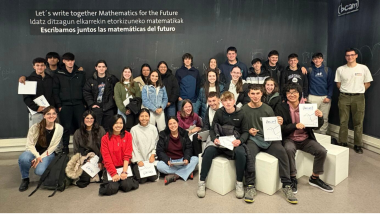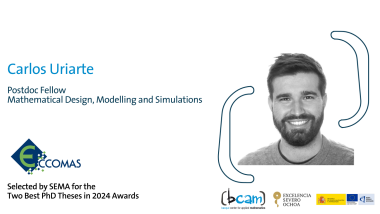Sandeep Kumar will defend his doctoral thesis on Monday, June 15th
- Due to the restrictions caused by the COVID-19 pandemic, the defense will be held online and users will be able to follow it live
Sandeep Kumar obtained his B.Sc. and M.Sc. in Mathematics with a specialization in Computer Science from Sri Sathya Sai Institute of Higher Learning (India) in 2011 and 2013, respectively. In 2015, he also completed an M.Sc. in Mathematical Modeling in Engineering from MathMods, an Erasmus Mundus masters program awarding a joint degree from Università degli Studi dell'Aquila (Italy), Universität Hamburg (Germany), and Universitat Autònoma de Barcelona (Spain).
In 2016, he joined the Basque Center for Applied Mathematics as a PhD Student within the Analysis of PDEs research group. During this period, he has also spent three months at the University of California, Santa Barbara (USA) under Prof. Carlos García-Cervera.
His PhD thesis, Vortex Filament Equation for some Regular Polygonal Curves, has been supervised by Prof. Luis Vega (BCAM-UPV/EHU) and Prof. Francisco de la Hoz Méndez (UPV/EHU).
Due to the COVID-19 pandemic, the defense will be held online, through the platform BBCollaborate. It will take place on Monday, June 15th at 12 pm, and users will be able to follow it live using the following link: https://eu.bbcollab.com/guest/4d6c9f7457bb42e0a4644bf095aa6195
On behalf of all BCAM members, we would like to wish Sandeep the best of luck in his upcoming thesis defense.
Title: Vortex Filament Equation for some Regular Polygonal Curves
Abstract:
One of the most interesting phenomena in fluid literature is the occurrence and evolution of vortex filaments, i.e., smokes rings, tornadoes, etc. For an ideal fluid, there have been several models and governing equations to describe this evolution; however, due to its simplicity and geometric properties, the vortex filament equation (VFE) has gained substantial attention recently. In this thesis, we examine the evolution of VFE for regular polygonal curves both from a numerical and theoretical point of view in the Euclidean as well as hyperbolic geometry.
In the first part of the thesis, we observe the evolution of the Vortex Filament equation taking M-sided regular polygons with nonzero torsion as initial data in the Euclidean space. Using algebraic techniques, backed by numerical simulations, we show that the solutions are polygons at rational times, as in the zero-torsion case. However, unlike in that case, the evolution is not periodic in time; moreover, the multifractal trajectory of the point X(0, t) is not planar and appears to be a helix for large times. These new solutions of VFE can be used to illustrate numerically that the smooth solutions of VFE given by helices and straight lines share the same instability as the one already established for circles. This is accomplished by showing the existence of variants of the so-called Riemann’s non-differentiable function that are as close to smooth curves as desired when measured in the right topology. This topology is motivated by some recent results on the well-posedness of VFE, which prove that the self-similar solutions of VFE have finite renormalized energy.
In the rest of the work, we delve into the hyperbolic setting and examine the evolution of VFE for a regular planar l-polygon in the Minkowski 3-space which is characterized by a parameter l>0, i.e., the angle between any of its two sides. Unlike in the Euclidean case, a planar l-polygon is open which makes the problem more challenging from a numerical point of view. After trying several numerical methods, we conclude that a finite-difference discretization in space combined with a Runge-Kutta method in time, give the best numerical results both in terms of accuracy and computational cost. On the other hand, using theoretical arguments, we recover the evolution algebraically, and thus, we show the agreement between the two approaches. During the numerical evolution, it has been observed that the trajectory of a corner is multifractal and as the parameter l goes to zero, it converges to the Riemann’s non-differentiable function.
Furthermore, as in the Euclidean case, we provide strong numerical evidence to show that at small times, the evolution of VFE for a planar l-polygon as an initial datum can be described as a superposition of several one-corner initial data. As a consequence, not only we can compute the speed of the center of mass of the planar l-polygon theoretically, the relationship also reveals important properties of the multifractal trajectory of its corners which we compare with its equivalent in the Euclidean case.
Finally, a nonzero torsion in the hyperbolic case, yields two different kinds of helical polygonal curves, however, with the numerical and theoretical techniques developed so far, we are able to address them as well. This remains part of the future work of the thesis.
Related news
About the center
About the center




